Choosing aftermarket suspension for your car doesn’t have to be difficult. Despite the wide range of options out there, most of us can narrow down our choices by asking one question:
Are coilovers, or springs and shocks better for my application?
The catch is, this initial choice before looking at the individual products, isn’t so easy to make.
Many people will say to use ‘lowering springs for street, coilovers for track’, but that can be a misguided opinion.
In this article, we’ll review the true differences between coilovers and shocks using lowering springs, and why one may be better than another for your unique scenario.
Lowering Springs
Typically the cheaper option, lowering springs are mostly considered the easiest way to lower a car.
Best for those on a tight budget and are considering a DIY install, lowering springs can be quicker to install than coilovers, however many coilover manufacturers are shipping their setups pre-assembled and with great guides nowadays, so this isn’t always the case.
There are however, some things that you should consider when comparing lowering springs with coilovers.
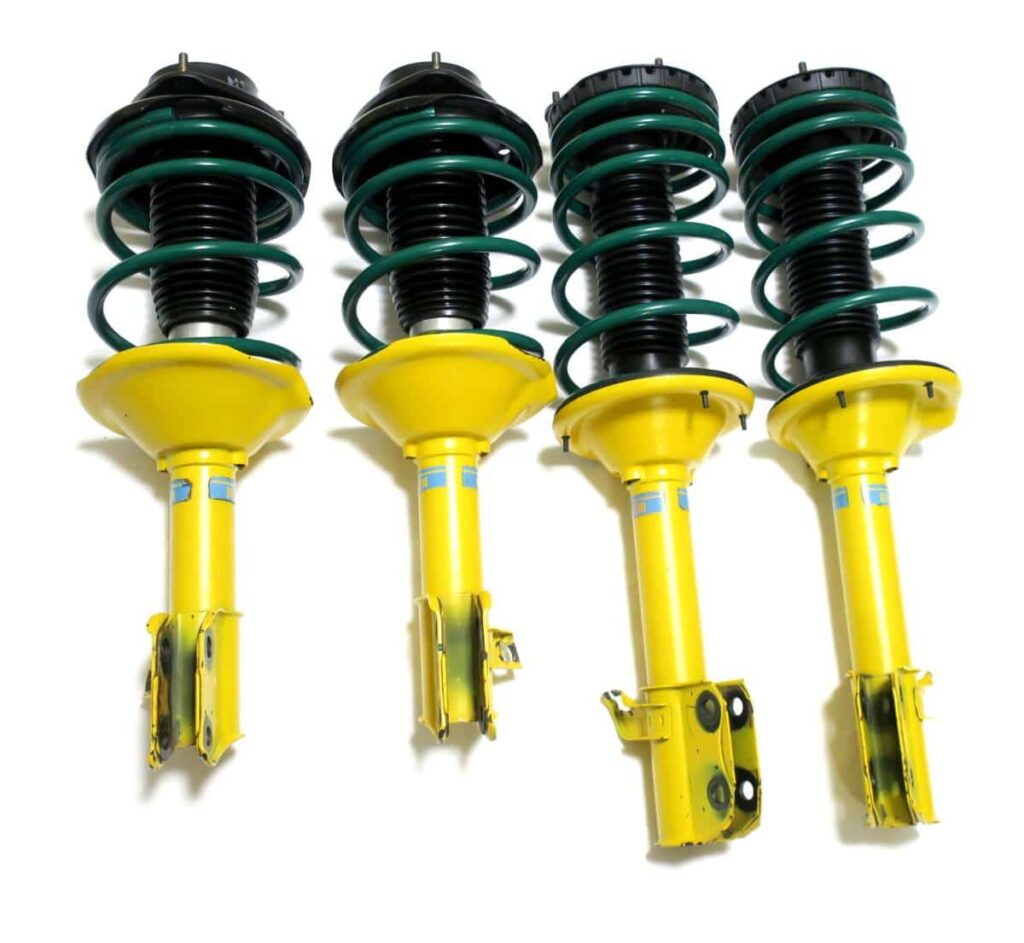
The Ride
When using a lowering spring on your car, the spring has a shorter length, while the weight of your car remains the same.
This may be obvious, but what isn’t obvious is that your new spring has less room to support the same amount of weight.
Your new springs need to work harder, meaning they need to use a higher ‘spring rate‘. This is what people are referring to when they say how ‘firm’ a spring will be – lowering springs need to be firmer and the result can be a harsher ride quality.
This isn’t always a negative, some people prefer to ‘feel more of the road’ through their car, but it’s an important consideration when considering how to lower your car – especially if you have family members to keep happy.
The ‘Drop’
Lowering springs are typically sold in 0.25″/~6.5mm increments, meaning you won’t be able to get the fine tune the ground clearance or ride height of your car as well as you can with coilovers.
But while each brand may offer the same amount of drop, in the real world each brand can be different.
We’ve seen cases where a coilover is a full quarter inch higher than the claimed drop provided, so it’s worth doing research specific to your car and spring-type before buying.
This is one area where most coilovers are a clear winner against lowering springs – you can adjust your drop down to the millimetre.
The exception to this rule is the newly released H&R VTF lowering springs, which do offer height adjustment.
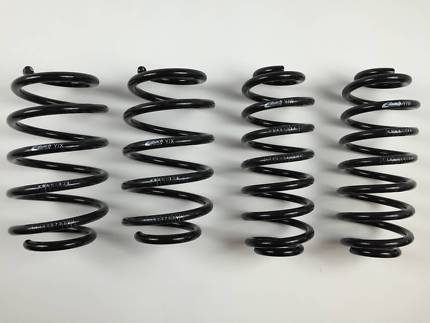
Handling
The good news is, by lowering the center of mass of your car, it’s likely to feel much more stable on the road, and you’ll experience better handling. Your car will be less likely to body roll through the corners, giving you more control as it stays flat through each turn.
Due to a lack of adjustability and perfectly matched springs with dampers however, you will be hard pressed to get the same sort of handling performance as coilovers.
Pros and Cons of Lowering Springs
Whether you’re looking for coilovers or lowering springs for daily driving, or to compare them for the track, the pros and cons of lowering springs are fairly consistent.
Pros
- Price
- Simple to install
- Looks more OEM/factory standard
- less likely to cause trouble with the authorities
- can be better for daily driving
- less likely to void a warranty, outside of the shocks and struts
- Progressive springs can provide greater comfort than the linear springs found on most coilovers
Cons
- Lack of adjustability
- Spring rate not always matched to damper
- Stiffer springs can cause a rougher ride
- Mismatched valving and spring rate can cause faster wear of shocks and struts
- If you also need to buy a strut spring compressor tool, you can almost afford an entry level set of coilovers

Coilovers
Quality for quality, coilovers are more expensive than lowering springs. This makes sense, as coilovers are essentially a shock and spring which is integrated and matched together.
It’s unrealistic to expect a set of coilovers, which comes with springs, to be the same price as lowering springs.
Of course, if you’re comparing lowering springs vs cheap coilovers, you’ll likely find a set that match your budget in each category – but it’s worth asking; why is this set of coilovers the same price as 4 lowering springs?
Chances are you’ll have a better experience with a high quality set of lowering springs than the cheapest coilovers you can find.
But if you’re willing to spend a few extra bucks, coilovers can provide a much better outcome. One of the biggest differences between coilovers and struts with lowering springs is adjustability.
Coilovers typically give you far more options to adjust your suspension geometry and other settings, including:
- height
- compression
- rebound
- preload
- camber angle
- caster angle
One of the less-talked about benefits of coilovers vs lowering springs is the fact that the spring and shock are a perfect match. When adding a lowering spring to a standard shock or strut, the spring rate, shock length and shock valving often doesn’t match.
It’s not a concern for everyone, but this can affect the general ride of your car including how it handles and corners.
In extreme cases, lowering springs can come loose if there is too much travel in the shock – not something you want to happen out on the streets!
Height Adjustment
Almost all models of coilovers allow you to tweak ride height height (to the millimeter) by using an adjustable collar on the threaded coilover body.
So while a lowering spring may offer a 1.25in/31.75mm drop, a coilover may give you range of 0.8-2.3in/20-60mm in drop.
This means you are able to get your car riding at your absolute desired height – necessary for making sure tire to guard gap is perfect, and eliminates the problem of springs that ride slightly too high in the front and too low in the rear.
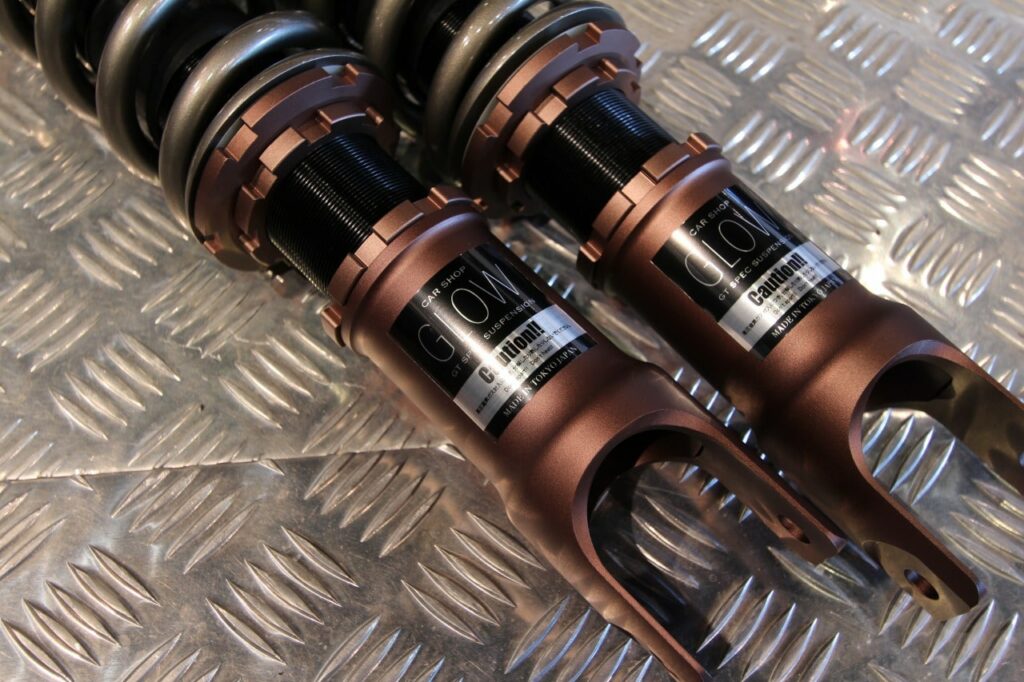
Rebound Damping Adjustment
Rebound is the force that is experienced when a shock returns from its compressed state to its original state. Think about hitting a bump, hard – your wheel will lift up into the guard of your car.
Rebound adjustment controls how quickly, or slowly, your wheel is pushed back to the ground.
Sometimes this feels bouncy or stiff because of spring rate and/or damping force settings don’t match each other—one is either too stiff or too soft.
This is one of the major difference between coilovers and shocks with lowering springs. Often the lowering springs aren’t matched to the shock, and therefore the rebound isn’t set up correctly.
By using a coilover with adjustable damping force you can control this experience, greatly improving performance, comfort and safety at the same time, by keeping your wheels on the road for more of the time.
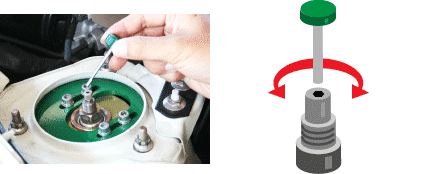
Compression (Bump) Adjustment
Though the least common of all coilover adjustment features, compression, or bump adjustment features on higher-end units and allows for finer tuning, especially important for those heading to the track.
When hitting a bump, the coilovers absorb the upward movement of the car, then the dampers go into rebound.
In an under-damped car, this continues until the car returns to the original position, causing a bouncing motion to the car.
If there is too much damping, it’s similar to having little to no suspension in your car – any upward motion from bumps will be sent to the chassis. Your tyres and other suspension components will work harder, as will you at the wheel! Expect lack of traction in high-power cars.
While higher damping is suited to the track, it creates an uncomfortable and difficult to drive car on the streets – not the best for daily driving.
The highest quality adjustable coilovers will feature both low-speed and high-speed compression adjustment. As it sounds, these features allow you to adjust compression for bumps at high-speed, and for low-speed such as cornering and braking.
Combined with multiple options on spring rates, and you can end up with a very custom set of suspension.
Adjustable Upper Mounts (Caster & Camber Plates)
Coilover top hats go by so many names due to their wide range of variations and adjustability, though most people tend to call them “camber plates”.
Essentially an upper mount or top hat refers to the plate that bolts the top of your coilover to the chassis. It’s most common for them to only be used in the front of the car, but it depends on your make and model of both car and coilover.
Many top mounts are not adjustable, and some brands require you to use your OEM strut top hats, as supplied from factory.
Higher-end coilovers however, offer adjustable upper mounts, which can give you far greater range of adjustment for aligning your suspension.
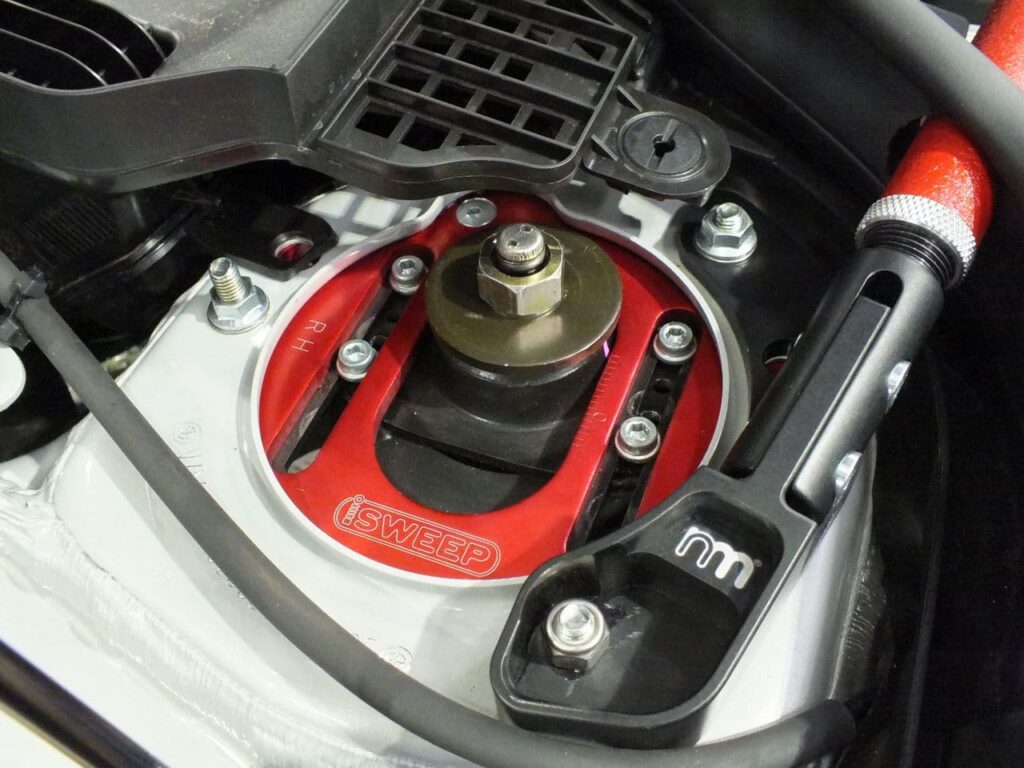
Camber
Nearly all adjustable upper mounts allow for camber adjustment, which is why many people refer to them as “camber plates”. This allows for you to dial in far more camber than is possible using your car’s standard range of adjustment.
Negative camber is commonly used by people before heading to the track, as it allows for more grip during cornering.
It’s also popular for those running low or negative wheel offsets, by those looking for the ‘stanced‘ or ‘flush’ look, as it allows for fine tuning the wheel gap between the tire and your guard.
Caster
Less common than camber-only plates, coilover top hats with caster adjustment tend to be paired with race-specific, adjustable coilovers.
Adjusting caster angle allows you to move your wheel hub forwards or backwards from a vertical position. Most cars come from factory with a degree of caster already used, as it makes the car more stable and allows the steering wheel return to center more easily.
More caster can be confidence inspiring for enthusiasts, as straight-line stability improves and during cornering the caster also increases camber, however this comes with heavier steering which can make your car less responsive.
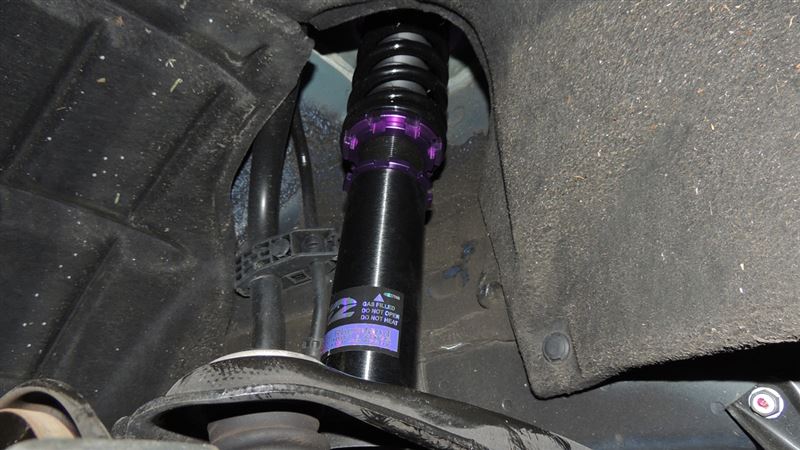
FAQs
Why Are Coilovers Better Than Springs?
Though it’s a matter of opinion, many people consider coilovers to be the best option as the damper is matched to the spring rate.
In addition to this, coilovers usually offer a lot of additional areas of adjustment, which can help to fine tune both ride quality on the street, and performance on the track.
Why Are Coilovers So Expensive?
For the most part, it’s because you’re getting more. Lowering springs don’t come with dampers or top hats.
This said, it depends what you’re looking for. For track use, you can find coilovers that are the same price as lowering springs, and they perform really well.
Where it becomes tricky is for street use. Unless your local roads are silky smooth, the cheaper coilover kits can really hurt the ride quality of your car.
What Is the Difference Between Coilovers and Springs?
The main difference is that coilovers are an integrated unit, whereas springs are just one component of the MacPherson strut unit.
Other differences include the wide range of adjustment that coilovers offer.
How Long Do Coilovers Take To Install?
Obviously this varies based on your experience, but assuming you have a low profile trolley jack and a quality socket set, you can install a set of coilovers in 2-3 hours.
Where this can take a lot longer however, is finding the perfect ride height and quality. Since there’s a lot of adjustment available in coilovers, you can burn a lot of time in getting everything millimeter perfect.
New coilovers typically settle in over a few drives, so your car will drop a ¼″ or ½″ after this. For this reason, it can take some time to find the right set up, especially if you’re seeking perfect wheel fitment.
How Long To Install Lowering Springs?
Lowering springs will take longer to install than coilovers if your car has a MacPherson strut set up. This is because you need to remove the strut unit, then separate the factory springs from that unit using a spring compressor.
You don’t want to rush that part of the process as it can be dangerous if you get it wrong. After removing the factory springs, you then install the lowering springs on the strut unit, and reinstall the entire unit in your car. You’re probably best budgeting 3-4 hours to get it done.
If your springs simply sit on a perch and you’re not replacing your current shocks, which is common in the rear of many cars, you can probably sort all four corners of your car in 2-3 hours instead.
How Much Do Coilovers Lower Your Car?
This really depends on the make and model of coilovers. Most coilovers will lower your car by 0.5″ to 3.5″.
Some models are designed to make your car super low. To get a 4.0″ drop or more though, you’ll have to do your research to find them as they’re not so common.
How Much Are Lowering Springs?
Expect to pay anywhere from $100 to $800 for a set of lowering springs. Like most car parts, it depends on the quality you choose and how common your car is.
As a general rule of thumb, you can usually get a reasonable set of springs for most makes and models of cars around the $250 price tag.
Coilovers vs Lowering Springs: It Depends
There’s no simple answer in this debate, but if you’re still unsure, know that adjustable coilovers are much more complex units than lowering springs.
If you are limited to a low budget, say $300, you’re going to get a better product by purchasing a set of lowering springs rather than a budget set of coilovers.
But if you’re looking for true adjustability, performance and the best possible outcome, a set of quality coilovers that is well set up is going to be very difficult to beat, even with a well matched shock and spring combination.
It’s almost always best to install coilovers before upgrading wheels, but even if you’re going with lowering springs it’s still safest to do your suspension upgrades first.

